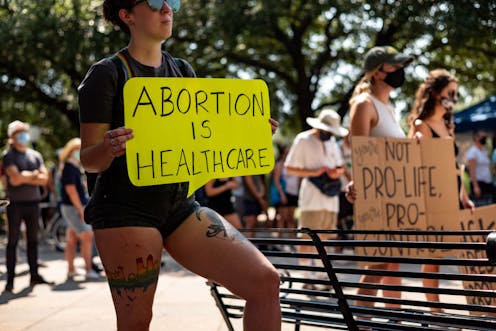Study shows an abortion ban may lead to a 21% increase in pregnancy-related deaths
Carrying a pregnancy to term is riskier than having an abortion, especially for non-Hispanic Black women.


A new Texas law bans nearly all abortions, and other states have indicated that they likely will follow suit. But the research is clear that people who want abortions but are unable to get them can suffer a slew of negative consequences for their health and well-being.
As a researcher who measures the effects of contraception and abortion policy on people’s lives, I usually have to wait years for the data to roll in. But sometimes anticipating a policy’s effects before they happen can suggest ways to avoid its worst consequences.
In my forthcoming peer-reviewed paper, currently available as a preprint, I found that if the U.S. ends all abortions nationwide, pregnancy-related deaths will increase substantially because carrying a pregnancy to term can be deadlier than having an abortion.
Pregnancy is riskier than abortion
Banning abortion does not stop people from trying to end their pregnancies. But it won’t result in a return to the kinds of unsafe abortion that killed hundreds of women per year before the Supreme Court’s ruling Roe v. Wade legalized abortion in the U.S.
Recent advances in medication abortion, which relies on prescription drugs rather than a procedure, have made safer abortions outside of clinics possible. They set the stage for organizations like Plan C to help pregnant people safely manage their own abortions with pills if they want or need to.
Staying pregnant, on the other hand, carries a greater risk of death for the pregnant person than having an abortion. Abortion is incredibly safe for pregnant people in the U.S., with 0.44 deaths per 100,000 procedures from 2013 to 2017. In contrast, 20.1 deaths per 100,000 live births occurred in 2019. In the U.S., pregnancy-related deaths occur for many reasons, including cardiovascular conditions, infections and hemorrhage caused or worsened by being pregnant or giving birth.
One possible future with an abortion ban
Policies like the abortion bans sweeping the U.S. may affect pregnancy-related deaths in several ways. In my study, I estimated a portion of the additional deaths that would be caused by a nationwide ban on all abortions.
To do this, I used published U.S. pregnancy and abortion death rates to project how many deaths would occur if all pregnancies that currently end in abortion were instead continued to miscarriage or term. My conservative estimate found that the annual number of pregnancy-related deaths would increase by 21% overall, or 140 additional deaths, by the second year after a ban.
Among non-Hispanic Black woman, this percentage would increase 33%, causing 78 additional deaths and exacerbating the ongoing U.S. Black maternal health crisis. The pregnancy-related death rate for non-Hispanic Black women is about three times higher than for non-Hispanic white women and Hispanic or Latino women, likely because of structural racism, biases in health care provision and disparities in health care access, among other reasons.
In reality, these figures could be higher. They do not account for the fact that people having abortions are on average less advantaged than people having births and at a higher risk of pregnancy-related death. Nor do they include the risks of using less safe abortion methods.
This possible future does not have to come true
Projections always rely on assumptions about how the future will unfold – they are warnings, not predictions. My estimates describe how deaths would increase if everyone who currently has abortions instead carries their pregnancy to term.
But the federal government, other states and nongovernmental organizations could make state abortion bans less deadly.
The assumptions behind my projections show us how to prevent what I warn could happen. For example, effectively addressing the maternal health crisis could make pregnancy safer and reduce pregnancy-related deaths. Helping people access safe medication abortion and travel across state lines to get to an abortion clinic would reduce pregnancy-related deaths. And not banning abortion in the first place would reduce pregnancy-related deaths the most.
Amanda Jean Stevenson receives funding from the William and Flora Hewlett Foundation and the Eunice Kennedy Shriver National Institute of Child Health and Human Development. Her statements do not represent those of her funders.
Read These Next
West Coast levee failures show growing risks from America’s aging flood defenses
Levees protect more than 7 million buildings in the US today, yet they got a D-plus grade in 2025. A…
LA fires showed how much neighborliness matters for wildfire safety – schools can do much more to te
Managing fire risk is about more than regulations and rules. It’s also about caring for neighbors…
Has the Fed fixed the economy yet? And other burning economic questions for 2026
As 2026 begins, uncertainty is at the top of everyone’s mind.






